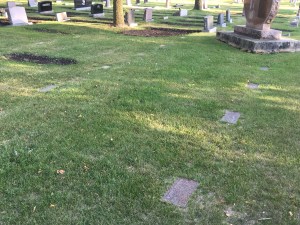
When I googled “Niverville Heritage Cemetery”, I noticed that someone had given it five stars in a Google review. I find the notion of rating cemeteries online pretty amusing. I mean, what would the accompanying review say? “I had a top-notch experience when I visited this cemetery…”?
Whatever. If you judge by my very strange feature photo, it really does look like I had a top-notch experience. But sorry to say, I have not reviewed this (or any) cemetery on Google or any other platform. Nor is this a review.

We visited this cemetery on a very bright day in September. Actually it was early evening, around 6:00. After work I had pestered Andrew into driving around the countryside with me in search of cemeteries, and figured we should visit this one. Mostly because we knew where to find it. (Main Street Niverville!)
First we visited Streich, and then we visited Niverville.
I don’t actually know much about Niverville, other than the fact that it had almost been called Hespeler. But in the end it was not. Yet I suppose Hespeler won in the end, since a LOT of stuff is named after Hespeler in Niverville anyway. (I still need to learn about Hespeler.)
There are a lot of plaques at this cemetery. Here they are!


The above plaque says this:
“IN RECOGNITION — This plaque is dedicated to the men and women of our community who have followed the rich tradition of volunteer service, dating back to our pioneer roots, in building a strong, vibrant Town in which to live, learn, work, play and raise our families. ‘May the Lord our God be with us as He was with our father; may He never leave us nor forsake us. may he turn our hearts to Him, to walk in all His ways…’ 1 Kings 8:57-58 Council of The Town of Niverville September 14, 1997”

The above plaque says this (and charts the town’s history):
“NIVERVILLE — In 1877 the CPR chose to name this sparsely populated area after Chevalier Boucher de Niverville, an officer of the company of Legardeur de St. Pierre who succeeded La Verendrye in charge of Western Posts. Niverville’s pioneers had arrived during the early 1870’s. English and Scottish settlers with surnames such as Church, Grant, and Wallace struggled to mold the virgin prairie into prosperous farms. From 1874 to 1878 Niverville, as part of the East Reserve, served as an entrance point for 3000 Mennonites who settled in South Eastern Manitoba. Families such as Hiebert, Kliewer and Dyck established homesteads in the area. Soon a multi-ethnic community developed. The railway arrived in 1878. During the same year an official plan for the town was registered on 30 acres of the NW1/4 of Section 30-7-4E by the Hon. William Hespeler. This visionary town father, also constructed here in 1879 the community’s first hotel and the first grain elevator of Western Canada. It supplied the first Western Canadian barley ever shipped privately to overseas markets. On May 1, 1879 Niverville’s first post office was opened. A school soon followed in 1884 with Presbyterian church services being held therein in 1885. Niverville was incorporate as a Village on January 1, 1969 and as a Town on January 1, 1993.”





“Vater Hier Ruht Im Herrn Aeltester Der M.B. Gemeinde Wilhelm I. Dyck Geb. 4 Feb. 1854 Russland Gest. 2 Maerz 1936 Niverville”Wilhelm I. Dyck had been the Aeltester for the M.B. Church in Manitoba at the time of immigration. He is buried in Niverville. We had not known that until Andrew found his headstone. It’s a new one, so someone is taking care of it!
So… even though this isn’t a review… I will still say, well done, Niverville. I am satisfied with the amount of descriptive plaques and renewed grave markers.

